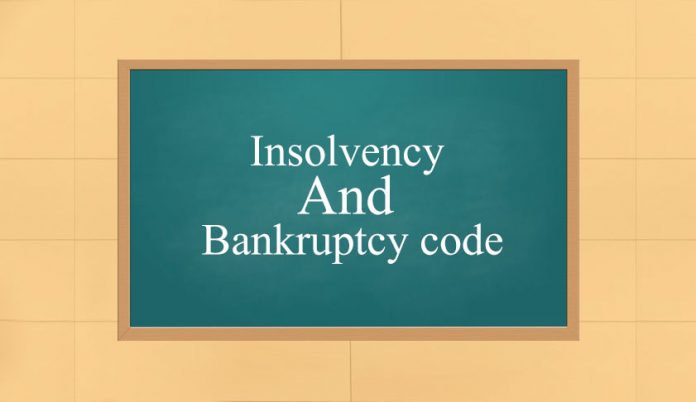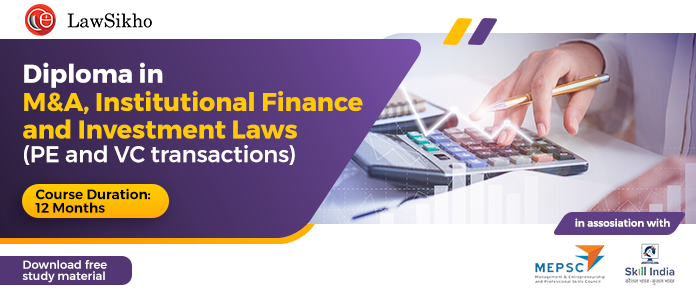This article is written by Aritrika Ganguly pursuing a Diploma in Law Firm Practice: Research, Drafting, Briefing and Client Management at Lawsikho. This article has been edited by Ojuswi (Associate, Lawsikho).
This article has been published by Sneha Mahawar.
Table of Contents
Introduction
The Insolvency and Bankruptcy Code was passed in the year 2016. Its main aim was to solve insolvency problems between companies, be it of corporate persons, partnership firms or individuals. As published in the official gazette, the main aim is to promote entrepreneurship and credit availability, ensuring the balanced interests of all stakeholders and promoting time-bound resolution of insolvency in the case of corporate persons, partnership firms and individuals. This process has changed the debtor-creditor relationship. It is one of the most important laws in India as it helps in doing business smoothly.
Section 29A of the Insolvency and Bankruptcy Code, 2016, was introduced by way of the Insolvency and Bankruptcy Code (Amendment) Ordinance, 2017. It provides the provision for the people who are ineligible to become a resolution applicant or apply to the resolution process. The main purpose of this Section is to rule out unreasonable and unfair elements and to prevent their personal interests so that it does not get in the way of the resolution process. This article talks about the judicial interpretation of this section in the case of Bank of Baroda v. MBL Infrastructures Ltd & Ors.
Facts of the case
MBL Infrastructures Limited (hereinafter referred to as Respondent 1) gained loan and credit facilities from a consortium of banks. Since Respondent 1 failed to comply with the terms of repayment, other respondents were forced to take advantage of the personal guarantee provided by Mr Anjanee Kumar Lakhotiya (the Promoter, Chairman and Managing Director of MBL Infrastructures) i.e., Respondent 3 for the loan funds used by Respondent 1.
RBL Bank issued a notice under Section 13(2) of the Securitization and Reconstruction of Financial Assets and Enforcement of Security Interest Act, 2002 (SARFAESI Act), wherein a borrower is required to discharge all his liabilities to a secured creditor in case he makes any default in repayment. And accordingly, RBL Bank initiated an application before the National Company Law Tribunal, Kolkata (referred to herein as “adjudicating authority”) for the commencement of the Corporate Insolvency Resolution Process (CIRP) against Respondent 1 and the appointment of an Interim Resolution Professional.
Respondent 3 was subjected to submit an appropriate resolution plan as decided in one of the meetings of the Committee of Creditors (CoC) held on November 18th, 2017.
Section 29A was introduced by way of the Insolvency and Bankruptcy Code (Amendment) Ordinance, 2017. This section provides for the eligibility to be a resolution applicant.
The Committee of Creditors met on December 1st, 2017 to discuss Respondent 3’s eligibility in submitting a resolution plan in the CIRP process, especially after the amendment. In light of the persistent suspicions raised, Respondent 3 filed a petition requesting a statement that he was not prohibited to submit a resolution plan under subsection (c) and (h) of Section 29A of the Code.
The adjudicating authority, in its judgement, stated that Respondent 3 has the authority to submit a resolution plan. However, he had provided a personal guarantee on behalf of Respondent 1, as mentioned by some creditors. The application submitted with the stated explanation was satisfied considering the amendments to the introduction of Section 29A on November 23rd, 2017.
However, the aforesaid decision of the Adjudicating Authority was questioned by RBL Bank and Punjab National Bank (Respondent 10) before the National Company Law Appellate Tribunal (hereinafter referred to as “appellate tribunal”). The Appellate Tribunal ordered that the Adjudicating Authority would neither accept nor reject the resolution plan without its approval and dismissed their appeal.
Respondent 3 filed an application seeking the support of the creditors for the resolution plan. Consequently, the Bank of Maharashtra (Respondent 11) and Indian Overseas Bank gave their approval to the resolution plan accumulating 78.50% of the vote share, which is the requirement as per Section 30(4) of this Code.
The appellants (IDBI Bank, Bank of Baroda, Bank of India and State Bank of India) then appeared before the Supreme Court against the order passed by the adjudicating authority.
Appellants’ submission before the SC
Section 29A of the Insolvency and Bankruptcy Code, 2016, provides for the eligibility requirements to become a resolution applicant. The basic purpose of this section is to eliminate the unwanted potential resolution applicants in order to promote debt superiority by disqualified guarantors who have failed to fulfil the same comprehensive liability as because of bankruptcy. According to Section 29A(h) of this Code, Respondent 3 was ineligible to submit a resolution plan as he had provided a personal guarantee on behalf of Respondent 1, as mentioned by some creditors. The learned counsel for the appellants argued that this fact was not considered by the adjudicating authority. And thus, the assumption that Respondent 3 is eligible to submit a resolution plan is incorrect.
The learned counsel for the appellants further submitted that along with Section 29A(h), Section 30(4) of this Code, shall also be considered because laws in force must be considered on the date of application. And thus, the application is subject to disqualification. Section 12 of this Code was also infringed as the resolution plan was approved much after the expiration of the CIRP period. Therefore, the judgment of the appellate tribunal supporting the adjudicating authorities’ judgment must be reversed and the appeal filed must be considered by the apex court.
Respondent’s submission before the SC
The Respondents submitted that the appellate tribunal accepted the revised plan as a measure of improvement over the previous plan. Strictly adhering to Section 29A(h) of the Code, a personal guarantor is barred from submitting a resolution plan only when the creditor invoking the jurisdiction of the adjudicating authority has invoked a personal guarantee executed in favour of said creditor by the resolution applicant. However, neither RBL Bank nor Allahabad Bank, nor State Bank of Bikaner and Jaipur applied to the adjudicating authority. The learned counsel for the respondents states that the object of the Code is the reinstatement of Corporate Debtor. Interference will be against its very purpose. They also further state that both the forums, i.e., the NCLT and NCLAT have rightly judged the matter and it needs no further clarification, whatsoever.
Supreme Court’s judicial interpretation of Section 29A of the I&B Code
The Supreme Court highlighted the objective of Section 29A in this case. It stated that the main purpose of this Section is to rule out unreasonable and unfair elements and prevent their personal interests so that it does not get in the way of the resolution process. Secondly, it tries to disqualify certain categories of people who would lack to provide credibility in the process.
The apex court then quoted the then Hon’ble Finance Minister of Finance and Corporate Affairs’ statement regarding the introduction of Section 29A while moving the IBC Amendment Bill, 2017. According to his statement, this Code lacked any ineligibility clause and thus Section 29A provides the provision for those who are ineligible to apply to the resolution process.
The Statement of Objects and Reasons of this Bill stated that the original IB Code did not provide any provision for the ineligibility of the Resolution process, i.e., there was no limitation on who can apply to the process or submit a resolution plan. This could have led to the misusing of the situation and an ineligible person would be awarded, therefore undermining the process laid down in the Code.
This statement was considered by the Supreme Court in the case of Chitra Sharma & Ors. v. Union of India AIR 2018 18 SCC 575. The court held that “Section 29A has been enacted in the larger public interest and to facilitate effective corporate governance.” The Court further observed that “Parliament rectified a loophole in the Act which allowed backdoor entry to erstwhile management in CIRP.”
Section 29A was included in the case of Arcelor Mittal Private Ltd. v. Satish Kumar Gupta 2019 (2) SCC 1. According to Clause (f) of this section, if a person is not eligible to trade in securities then disqualifications under sub-section (i) would attach. The word ‘control’ in Section 29A (c) means only active control and the mere authority of a company to bar a special resolution may not be sufficient to exert ‘control.’
The entirety of this Section was upheld by the Supreme Court in the case of Swiss Ribbons v. Union of India 2019 4 SCC 17.
Section 29A of the Insolvency and Bankruptcy Code, 2016 is designed to be an important link and is intended to ensure that the purpose of the Code is not compromised by allowing “unauthorised persons” including but not limited to, the owner of the company (the management members) who has made the business fall, may return as solution seekers.
Judgment by the Supreme Court
The Supreme Court, with Sanjay Kishan Kaul J., and M.M. Sundresh J., in the bench in its judgment observed that according to their understanding and interpretation of Section 29A, the resolution plan submitted by Respondent 3 should not have been accepted.
NCLAT (the adjudicating authority) and NCLT (the appellate tribunal) erroneously dismissed the applicant’s allegations because the previous complaint was withdrawn without deprivation of liberty and the eligibility issue can never be raised.
The Court upheld the adjudicating authority and the appellate tribunal’s decision on the question of limitation. Invocation of Section 12(3) of the Code for the delay was rightly condoned. It further states that the resolution plan submitted by Respondent 3 was ineligible for submission. However, it cannot be revoked as it has the mandatory voting share requirements, as per Section 30(4) of the Code.
As per the techno-economic report about the viability and feasibility of the resolution plan, the adjudicating authority has rightly accepted the resolution plan. Considering the main and the most important objective of the Code is to get corporate debtors back on track. Thus, according to the given facts of the case, the court decided not to revoke the resolution plan because it might interfere with the ongoing operation of Respondent 1.
Conclusion
This section establishes security for the company’s creditors by defending them against unprincipled individuals who, regardless of their previous defaults, are still attempting to reward themselves by risking the system. Consequently, throwing the resolution process’s fundamental goal out of the window. Under Section 29A of the Code, the Resolution Professional is responsible for making a due diligence report on potential Resolution Applicants and their associated people must be completed quickly and fast, according to NCLT’s timeline. The CoC has been given the authority to assess the Resolution Professional’s Due Diligence Report and to approve or reject the Resolution Plan.
Section 29A of India’s Insolvency and Bankruptcy Code, 2016, established a multi-layered and comprehensive criterion of disqualification that ensures bonafide Resolution Applicants’ exclusion. The application of this section may also prevent important or potential stakeholders from bidding for the company’s revival. To maximise the benefits and objectives of the code to creditors and the economy as a whole, a certain amount of tolerance by the courts in deciding the question of qualification is the need of the hour.
Students of Lawsikho courses regularly produce writing assignments and work on practical exercises as a part of their coursework and develop themselves in real-life practical skills.
LawSikho has created a telegram group for exchanging legal knowledge, referrals, and various opportunities. You can click on this link and join:
Follow us on Instagram and subscribe to our YouTube channel for more amazing legal content.
 Serato DJ Crack 2025Serato DJ PRO Crack
Serato DJ Crack 2025Serato DJ PRO Crack













 Allow notifications
Allow notifications



